► VW Golf Mk8 takes on rivals
► Fights new 1-series and Focus
► Does VW smash it once again?
VW’s survived Dieselgate and returned all guns blazing with a Mk8 Golf. But it must prove two things: that it’s better than the rest; and that the world still needs a Golf.
Keep reading for our comparison test of VW’s eighth-generation Golf, BMW’s latest 1-series and the Ford Focus. We’ll decide once and for all, who makes the best mid-sized family hatchback.
Pre-flight briefing: Volkswagen Golf Mk8
Why is it here?
Since 1974 VW has sold 35 million Golfs, or one every 40 seconds. So a new Golf is a significant waypoint for mankind, not just the business of car making.
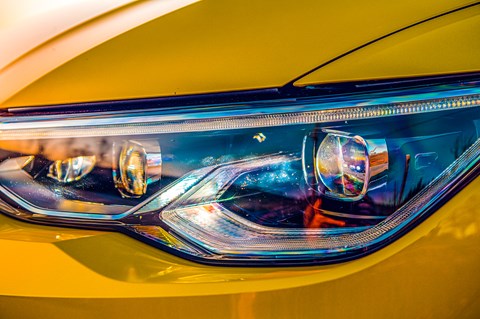
Any clever stuff?
Car-to-infrastructure capability, to receive and share warnings of hazards from/with other vehicles and traffic facilities; optional LED matrix headlights (pictured); Mobile Key (you can use your smartphone as the key); We Deliver, currently undergoing trials, whereby delivery drivers can leave parcels in your boot via a digital key; and We Upgrade, where features such as adaptive cruise control can be enabled retrospectively.
Which version is this?
There are four trim levels. Base trim; then Life; and the joint range-toppers R Line and Style, as tested here (plusher cabin). The engine range is an evolution of the Mk7 Golf’s, starting with 1.0-litre three-cylinder petrols and extending to a 2.0-litre TDI. New 48-volt mild-hybrid eTSI variants have also joined the range.
Check out our Golf Mk8 review
Pre-flight briefing: BMW 1-series
Why is it here?
Once curiously shaped, with a north-south powertrain and rear-wheel drive, the 1-series is now a conventional transverse, front-drive hatch, on the same underpinnings as the BMW X1, X2 and various Minis.
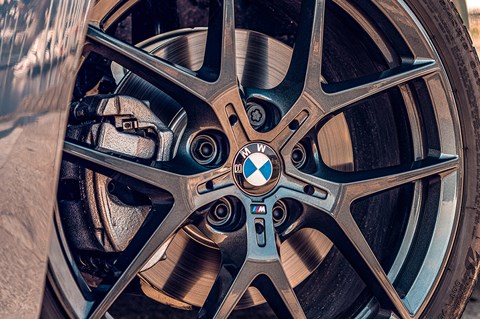
Any clever stuff?
ARB (translating as actuator contiguous wheel-slip limitation) is standard on all 1-series. It’s a wheel-slip controller that works directly with the ECU rather than further out of the loop in the stability control unit. The result is more controlled wheelspin, particularly handy for reducing power understeer for lead-footed drivers. First seen on the BMW i3S, the 1-series is the first combustion-engined BMW to feature it. And it works brilliantly.
Which version is this?
The entry-level engine, BMW’s now-familiar 500cc-per-cylinder turbo triple, is badged 118i here. M Sport trim brings 10mm lower suspension and a handsome bodykit. All 1-series get multi-link rear suspension where entry-level VW Golfs and Focuses use a torsion beam.
Check out our BMW 1-series review
Pre-flight briefing: Ford Focus
Why is it here?
The Focus conquered the Mercedes A-Class and Kia Ceed to become our reigning family hatch champ. Now there’s a new Golf and 1-series to give it a hard time, just as it was getting comfy on its throne. It’s the most affordable car here by a handy margin.
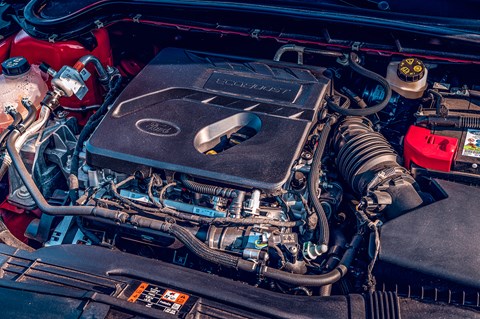
Any clever stuff?
Much of the technology is on a par with the competition, including autonomous halt and pull-away in traffic, speed sign recognition and speed adjustment, and headlamp patterns that adjust to bends ahead for optimum vision. Like the BMW, this Focus uses a three-cylinder turbocharged engine, and it’s a gem: quiet, flexible and so much punchier than its size suggests.
Which version is this?
This is the sporty-looking ST Line trim, Ford’s equivalent to M Sport or R Line. The range kicks off with 1.0-litre EcoBoost petrols and torsion-beam rear suspension. This 1.5-litre EcoBoost gets multi-link rear suspension and the optional auto gearbox – the latter we’d avoid.
Check out our Ford Focus review
Volkswagen Golf Mk8: back once again with the master
We know a great deal about the new Golf already. Of course we do – cars this important do not arrive unheralded. And the new Golf is important. When, last year, VW’s highest echelons were asked which of the company’s new-for-2019 hatchbacks, the all-new Mk8 Golf or the electric ID3, was the more important car, there wasn’t a moment’s hesitation: Golf.
We know the new Golf is technologically ambitious, beautiful on the inside and neat but conservative on the outside. But what’s it like to drive? Because that matters more than ever, when the rivals are this good. Ford’s Focus is a dynamic masterpiece and, incredibly, the new 1-series (with Golf-style transverse engine and front-wheel drive) is just as much fun to drive as its lairy, cramped and sideways rear-drive predecessor; just different. To cut to the chase, the Golf is excellent. On a fiendishly twisty stretch of Portuguese hill road, its corners by turns ultra-grippy or dew-drenched and slippery, depending on whether they’re in shadow or not, the Golf gets down to business.
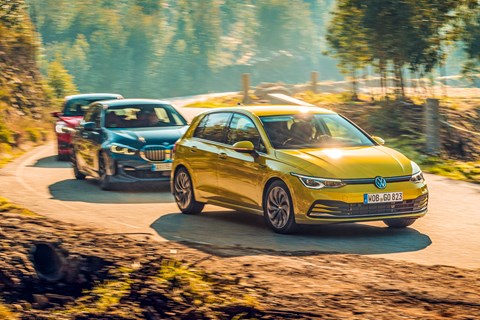
Delve into the Individual driving mode menu on the touchscreen, swipe the slider to full Sport to tighten the damping and off you go. The dynamic management system can adjust damping forces individually, to help quell bodyroll, and like the BMW it applies slight braking to individual wheels mid-corner to keep things neutral. Unlike the Ford, which is happy to swing its rear axle and help you rotate, the VW is unerringly composed. The standard steering rack has been quickened compared with the outgoing Mk7.5’s, and the optional progressive rack fitted here (less effort at low speeds, less lock at high) feels more natural than ever.
Tackling each corner with less braking and more preserved momentum, the Golf refuses to break sweat. You keep expecting it to collapse into excessive roll and depressing understeer but it never does. Certainly you’re aware of a layer of insulation from the action, but neither the BMW nor the Ford can drop the Golf.
And when, inevitably, you hit traffic and normal service is resumed, the Golf is the place to be. Its ride quality is staggering; just sublime on the occasionally awful southern European tarmac of our test route. (Or at least it’s sublime on the optional DCC – VW’s Dynamic Chassis Control – plus adaptive dampers and 17-inch wheels; the Ford and BMW ride on 18s as standard, and the VW can be ordered with 18s too.) Option prices are yet to be confirmed for the UK but reckon on having to find £1000 for the DCC kit – a lot of cash, but it’s also a lot of ride quality.
In Comfort, the Golf rides better than almost any other mainstream car you can think of. Potholes simply disappear yet the VW never relinquishes its body control; never yields to uncomfortable, confidence-sapping wallow. The Ford isn’t far behind, and achieves its bump isolation through more affordable, lighter and less complex means. The M Sport 1-series rides the same tarmac like a race car, crashing over ridges and communicating every lump and bump straight to the seat of your long-suffering pants. It boils down to the roads you regularly drive. If they’re smooth and empty, treat yourself to a more communicative, agile hatchback than VW’s latest, greatest Golf. But if, like most of us, you need your new car to do it all, from runs into town to motorway days to regular commuting missions, you’d be brave to ignore the VW’s astonishing bandwidth.
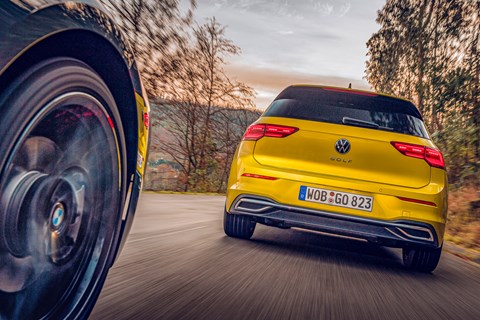
The new Golf’s engine range stretches from 1.0-litre tiddlers to 2.0-litre diesels, all of them based on the Mk7’s range but evolved for greater efficiency. There’ll be hybrids too, both plug-ins (including a hot GTE version) and mild eTSI, pairing petrol engines with a 48-volt starter-generator and battery. But this one is the hybrid-free 1.5-litre four-cylinder petrol, with cylinder deactivation and a six-speed manual gearbox. The shift is light of throw, wide of gate and fine but forgettable – a means to an end rather than a thing of mechanical joy like a Ford’s.
The 1.5-litre petrol four was a real star of the Mk7 Golf range, and it’s still great: so quiet you might need to lower a window to hear it running at idle, and as smooth as pâté. But it feels a touch less eager than it used to, and strained at high revs. Its cause isn’t helped by the Golf’s long gear ratios; twisty roads feel too fast for second gear, too slow for third. In both cases blame the need to reduce emissions.
But the Golf’s powertrain, and indeed its chassis, are but support acts for the main event: the interior. If the Mk4 brought executive saloon levels of finish and refinement to the hatchback, the Mk8 stuffs the full luxe Audi A8 limo experience into a humble £25k hatch. Strong horizontal design themes give a breathtaking sense of space and pared-back, boutique-hotel minimalism, helped by the de-cluttering effect of the touchscreen infotainment. The materials feel impossibly expensive – so soft-touch you’d worry for their durability were this not a VW.
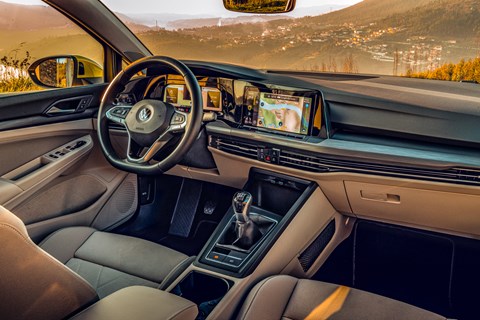
The primary means of interaction is via the 10-inch touchscreen (standard in the UK; entry-level German cars have an 8.25-inch screen) or by chatting to it. ‘Hello Volkswagen’ is the trigger phrase. Follow that up with ‘My feet are cold’ and you get the response: ‘No problem. Warming front-left [in our left-hand-drive test car].’ The car knows where you are and directs the airflow accordingly. Swish.
But as with so many new pieces of consumer technology, the Golf’s systems are frustrating as often as they’re joyous. For every quick, clever response, there’s a nonplussed request to repeat the question. And the touchscreen itself can be recalcitrant and slow to respond. It has an interface that needs concentrated learning, rather than intuitive menu-hopping on the fly. We might have been saddled with an unusually latent screen in our pre-production car; we’ve tried another that was far less laggy.
But the system can be so obfuscating you wonder if some traditional Golf buyers might be put off by a test drive. The modish slider controls used to adjust volume and temperature also don’t illuminate at night, and are slow to register your inputs, while the navigation map is awkward to pinch, swipe and pull about. The Tesla Model 3 just about gets away with its even more button-averse interior because its touchscreen is so intuitive and accessible; on the basis of this first meeting, the Golf’s just isn’t slick enough. Or at least, not yet. Like the Tesla, over-the-air updates may be able to smarten its interface over time.
So, the new Golf’s a much better car than it is giant smartphone. We’d far rather that than the other way around.
BMW 1-series: BMW’s Golf still very much a BMW
Clearly, the Portuguese don’t believe in the concept of lowest common denominator when it comes to pegging their motorway speed limits. We’re racing west, into the setting sun, and fading amber light plays across a mountainous landscape of sawtooth peaks, gut-churning drops and a serpentine stretch of dual carriageway. Overloaded Dacias churn up the climbs, unable to hold anything like the 120km/h limit. On the downhill curves, ancient Clios with dampers that no longer damp squirm at the limits of their equally ancient rubber.
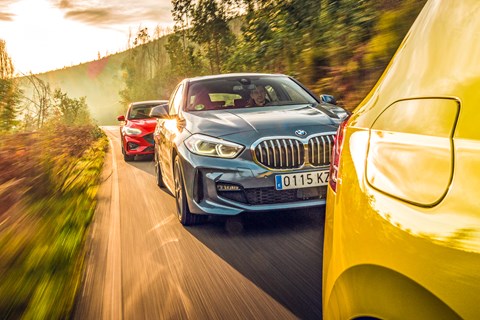
The 118i, by contrast, is imperious. Provided you’re carrying a little momentum the 1.5-litre turbocharged triple does a great impression of something far more powerful, hauling the BMW up each slope without fuss. And with gravity on your side you’re left wondering just how fast the 118i could tackle these fiercely three-dimensional curves. Fully double the posted limit? Probably.
The BMW carries its weight low, and – in true, er, Mini style – sticks a wheel (wearing a broad and grippy tyre) right out into each corner of the car. Steering is meaty and direct, with no real straight-ahead slack, and in combination with the uncompromising set-up (the BMW’s shockingly firm after the limo-pliant Golf) – the result is a level of communication and control that quickly builds confidence. A driver’s car, then, despite the heresy of front-wheel drive. In truth you wonder why BMW didn’t make the switch sooner.
Well, what would you do? Say you’re BMW and you’ve been making a hatchback with a rear-drive USP, with all the packaging disadvantages that entails, but research suggests a significant proportion of existing 1-series owners don’t even realise their car is rear-wheel drive – and by staying the way you are platform-sharing opportunities are being missed by the truckload. And if people didn’t notice which axle did the driving in their old 1-series, they certainly noticed that it had less space in the back and a smaller boot than their neighbour’s Golf.
That’s no longer the case. The three boots here are much of a muchness for size, shape and usefulness (although the two Germans have a touch more underfloor storage space than the Focus). And there’s far more rear space than before, although with the body’s high beltline pinching the rear windows and giant C-pillars, it still feels a touch cramped in the back of the BMW, particularly for tall passengers. All three cars are broadly similar for roominess, the Focus a smidge ahead for legroom and the Golf the headroom champ (the Ford’s hope of a win dashed by this particular car’s space-snaffling glass roof).
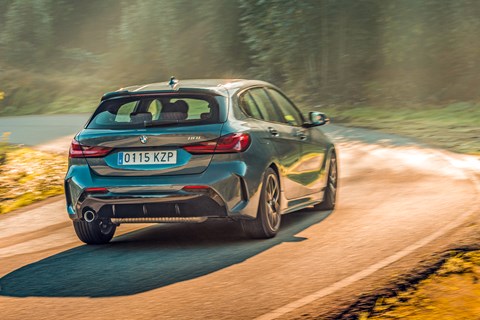
If the Golf’s interior is like a luxury limo decanted into a hatchback, the 1-series is bonsai sports saloon. M Sport spec brings deeply bucketed leather seats and textured trim, lifted by eye-catching patterned ambient lighting. The Golf has its own interior light show, trumping the BMW’s choice of six colours with up to 32 shades to toggle through, depending on spec. The Golf gets digi-dials as standard while basic 1-series use analogue dials, but with the appropriate option pack box ticked the binnacle matches the layout of BMW’s bigger cars with symmetrical digital instruments, although it has just the one main display to the VW’s choice of four. The BMW also adds a crisp head-up display, complete with shift lights. Like the VW, it’s projected directly onto the windscreen, while the Ford’s HUD is beamed onto a transparent strip of plastic.
The 1-series cabin is less impressive than the Golf’s (the map graphics in particular look low-rent compared with the Golf’s living, breathing OS map) but it’s the best infotainment here. Some mocked BMW’s shotgun approach on the 7-series and 5-series, as it pursued control via voice, gesture, touch and iDrive, but it now looks like a prescient decision. Traditionalists can iDrive, while the iPhone-trained can play on a screen more responsive than the Golf’s.
You can still crank the seat low, as you should be able to in a BMW, and like the Golf, the seats are superbly supportive. And while the ride is by far the firmest here (not least because M Sport spec includes a 10mm suspension drop), the 1-series is perfectly tolerable for daily use.
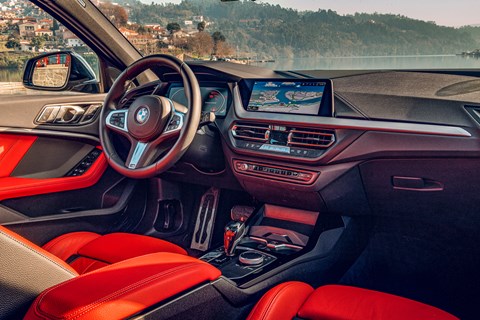
Has nothing been lost, then? Well, the new car hasn’t the unique character of the old 1-series, nor its balance. But it is an enjoyable hatch to drive, with communicative, adjustable handling. So clearly does the BMW tell you what’s going on at each corner, and so unobtrusively do its chassis systems work, that you always feel on top of it. The Golf is more comfortable. But the 1-series is the one you’ll remember.
Ford Focus: people’s car vs people’s car
One corner. That’s all it takes. The slightest turn of the Ford’s wheel and you’re smiling. Where the Golf’s measured and the BMW meaty, the Focus feels alert, eager.
This is the Ford’s USP: the ability to make a humdrum drive fun; every roundabout an arc of apexes to be kissed. Where the 1-series is all about taut, grippy, flat-stance cornering, the Focus is big on nailed-down front-end grip and a mobile, lightly oversteery rear axle. Both are fun, but a lot of the time it’s the Ford that gives you the bigger kicks.
The downside is that, as you experience them, you’ll be sitting in the drabbest interior here, by some margin. The inside of the Focus is underwhelming in isolation, but after the BMW and the VW it feels like a car from a decade ago. As interior tech increasingly becomes a differentiator and a key selling point, this deficiency can only put bigger dents in the Ford’s desirability.
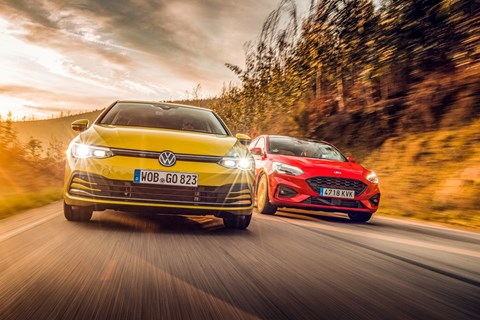
Still, everything’s in the right place, and simplicity itself to operate. Where in the VW you’re cursing (with or without voice control), the Ford is on your side. It too has voice control and a prominent touchscreen, which thanks to fonts bigger than a pensioner’s phone is mostly straightforward to use. And, like the BMW, the air-con controls are good old-fashioned buttons. If a lorry ahead coughs out a load of carcinogens, you hit the recirculation button. In the VW, you delve into a menu.
Ride quality on the optional adaptive dampers is agreeable, too. It’s not as memory-foam supple as the VW, but smoother than the 1-series. Like the Golf, lowly Focus variants get a torsion beam at the back. More powerful variants, including this car, feature multi-link rear suspension (standard on the 1-series). The Ford’s set-up is most masterful, the only unwanted by-product of that refreshingly pliant tune being a little extra bobbing through fast, bumpy corners, the movement exacerbated by the Ford’s quick steering. But on bubblier UK roads, the Focus is outstandingly comfortable.
We’d pick the standard manual gearbox, however. Not just because it’s sweet (one of the best mainstream shifts around) but because the eight-speed auto in this test car is as slow-witted as its take-up in stop-start traffic is abrupt. If you don’t want a manual, don’t buy the Ford.
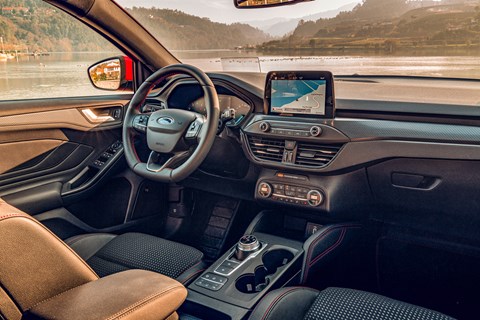
Gearbox and flair-free interior aside, badge snobbery is the Focus’s main enemy in this company. Even in faux-hot-hatch ST Line spec and with bright red paint, the Focus struggles to get noticed next to the Touring Car 118i and Tate Modern Golf. But you can’t miss its price. Golf pricing in the UK starts at £20,995 for a 1.0-litre petrol S and £21,735 for a Match with the same engine. The 1.5-litre Golf intoppy R-Line trim will set you back £26,630 but will be more given its options, including DCC and LED matrix headlights (which we’d pass on, given their lack of urgency to dim for oncoming cars at night during our test). The BMW starts in the mid-twenties for a 118i or 116d, with M Sport trim taking our test car to £27,230. (Our car’s option packs – including such goodies as digi-dials, HUD, heated screen and incredible stereo – take the price way past £30k, but that £27k is the key figure for a pared-back 118i M Sport.)
The Focus, meanwhile, can be had from £18.5k for a base-trim 1.0-litre, and a 1.5 in ST Line trim costs less than £24k (plus £800 for the adaptive dampers, and about a grand for the panoramic roof). Okay, so it’s not a huge a gulf in price, but it certainly helps give the Ford a handy tailwind.
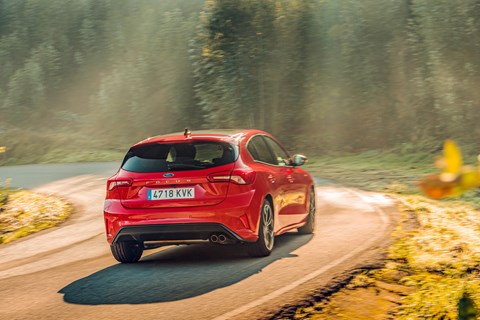
The Focus also has the strongest engine here. The Ford’s all-aluminium triple is much more flexible and stronger to pull from low revs than the Golf’s, despite its cylinder shortfall. What’s more, its bigger pistons give it more torque – the Volkswagen and BMW feel a tad weedy by comparison. The EcoBoost is coarser than the Golf’s smooth four, and it has a thrummier note than the BMW triple, but you can’t argue with the in-gear pull from low revs.
So, buy your 1.5 Ford with the manual gearbox, and smile at a chassis that’s gloriously fluid, fluent and adjustable. Although the interior falls behind the others on design and quality, Ford’s ride/handling genius is enough to overshadow that at times. (It’s worth bearing in mind that the chassis of the Focus ST is even better, and the ST is not all that much more expensive than the BMW without options.) And smile because, while the Ford’s Sync infotainment feels conspicuously off the pace, CarPlay sidesteps that neatly. Smile too at what is appreciably the strongest engine here. That’s a lot of smiling.
The final reckoning
The Focus is more fun to drive than any mainstream hatch since, well, the first Focus, and the Peugeot 205 before it. It’s the most affordable car of these three, the least pretentious, its engine is a peach, it’s practical and, for some, its incredibly fluid and adjustable handling make it the winner. But for the rest of us the Ford is lacking in this company; its interior feels a generation behind, and it’s short of the gotta-have-one appeal the Germans have bestowed upon their new-generation hatches.
The Golf is laudably ambitious, democratising the kind of design and technology previously reserved for cars four times its price. It is by some margin the most comfortable car here, and it drives beautifully – not as involving or lively as the 1-series or the Focus, sure, but with an endlessly pleasing balance of agility, composure and refinement.
But for the first time in ages there are a couple of reasons why you might not buy a Golf. One of them, paradoxically, is its show-stopping interior. It’s beautifully put together, stunning to behold and a timely reminder of the fundamentals the Golf has always got right: great visibility, superbly supportive seats with plenty of adjustment, and a sense of space at odds with the car’s size. But the new interface just isn’t intuitive enough. Even if you’re a digital native, fluency will take some soak time. Volkswagen should be applauded for taking a risk on the new Golf’s cabin (particularly since the exterior is so safe) and, had it been more cautious, it would be weathering criticism for being dull. But the truth is the other cars are easier to gel with.
The other reason is the 1-series. It blends much of the fun of the Focus with the premium sheen of the Golf, and has a more memorable character than either. Its cabin is less attractive than the Volkswagen’s but more intuitive to operate, and more expressive than the Ford’s. In the BMW’s migration to a Golf-esque engineering layout, it’s a shame that the hatch world has lost one of its few iconoclasts in favour of a more homogenised design. But the reality is that going transverse and front-drive has made the 1-series a more well-rounded car than ever – just as a new Golf turns up hoping the BMW’s still brilliantly weird. It isn’t: now it’s just brilliant. And it wins.
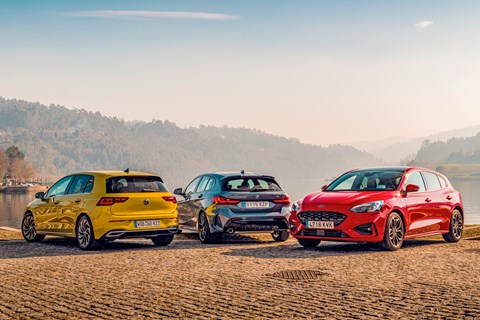
VW Golf vs BMW 1-series vs Ford Focus
First place: BMW 1-series
Doesn’t re-write any rulebooks – it’s just a fun, practical and desirable hatch. Like a Golf, but better.
Second place: VW Golf
Infotainment is not a roaring success but just about everything else is. Refined and desirable.
Third place: Ford Focus
Great to drive and the 1.5 petrol engine is a star. Just lacks gloss and premium appeal.
Check out more CAR comparison tests